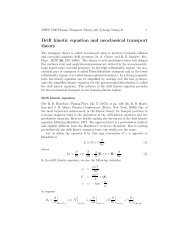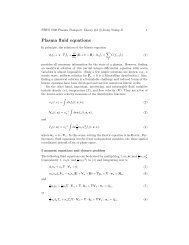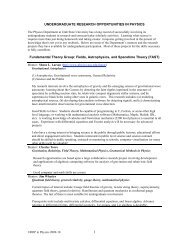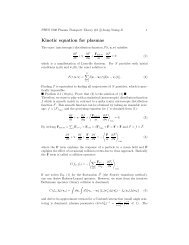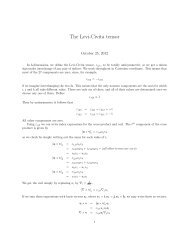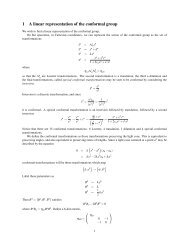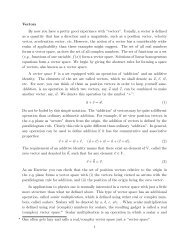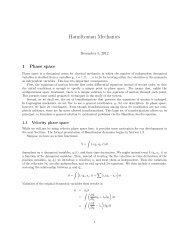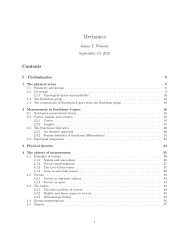- Page 1 and 2:
Contents I Preliminaries 5 1 Physic
- Page 3 and 4:
11.2.1 Are inequivalent Lagrangians
- Page 5 and 6:
Part I Preliminaries Geometry is ph
- Page 7 and 8:
Several important features are impl
- Page 9 and 10:
and physicists have returned again
- Page 11 and 12:
and partition the decimal expansion
- Page 13 and 14:
2.1. Symmetry and groups Mathematic
- Page 15 and 16:
For the nal case, we have two subca
- Page 17 and 18:
one of the elements must be the ide
- Page 19 and 20:
2.2. Lie groups While groups having
- Page 21 and 22:
Denition 2.12. A topological space,
- Page 23 and 24:
for some xed dimension n. Here is
- Page 25 and 26:
1 which shows that TaTb = Ta+ b and
- Page 27 and 28:
We now have R R x x = x x This exp
- Page 29 and 30:
and may therefore be written as ⎛
- Page 31 and 32:
such that ′ ′ ′ ′′ p ( R
- Page 33 and 34:
3.2. Curves, lengths and extrema So
- Page 35 and 36:
Perhaps more important for our disc
- Page 37 and 38:
2 Most functionals that arise in ph
- Page 39 and 40:
′ where we omit terms of order (
- Page 41 and 42:
But the point 0 was arbitrary, so w
- Page 43 and 44:
such that at extrema, Let f be give
- Page 45 and 46:
sequences of functions. Therefore,
- Page 47 and 48:
∫ ( n) 3. Evaluate f( x) ( x) dx
- Page 49 and 50:
Since we have chosen hm ( ) to ap
- Page 51 and 52:
Remark 3. To dene higher order deri
- Page 53 and 54:
= ∫ ∫ + 1 2 ∂ d1 d2 ( 1 2
- Page 55 and 56:
for some tensors of each type, then
- Page 57 and 58:
1 mi or, multiplying both sides by
- Page 59 and 60:
then use the identity of eq.(4.2) t
- Page 61 and 62:
and we have, simply, dLi Ni = dt We
- Page 63 and 64:
Exercise 4.4. Find the metric tenso
- Page 65 and 66:
After the geometric description of
- Page 67 and 68:
Notice that we have chosen to write
- Page 69 and 70:
forms and vectors, respectively, ev
- Page 71 and 72:
so that the linear map on curves is
- Page 73 and 74:
There is a natural duality between
- Page 75 and 76:
An inner product on the space of ve
- Page 77 and 78:
as a mapping from to by leaving one
- Page 79 and 80:
index is repeated, once up and once
- Page 81 and 82:
Exercise 4.12. The examples of Sect
- Page 83 and 84:
the metric in polar coordinates is
- Page 85 and 86:
4.4. Group representations One impo
- Page 87 and 88:
so the form of g is determined by i
- Page 89 and 90:
i j Of course, the most general 33
- Page 91 and 92:
use it elsewhere. Second, we use ea
- Page 93 and 94:
Part II Motion: Lagrangian mechanic
- Page 95 and 96:
i respect to q ( t) : 0 = S∫ = L
- Page 97 and 98:
again to nd k k dx˙ x = dt k k d
- Page 99 and 100:
Theorem 6.3. (Noethers Theorem) Sup
- Page 101 and 102:
6.2. Conserved quantities in restri
- Page 103 and 104:
or innitesimally, 1 2 S ∫ i i i
- Page 105 and 106:
Now consider the (vanishing) variat
- Page 107 and 108:
̸ Proof: Let x0 and v0 be the init
- Page 109 and 110:
Bringing both terms to the same sid
- Page 111 and 112:
for constants ( , , , ) . The Lagr
- Page 113 and 114:
so the variation gives 0 = S ) ∑
- Page 115 and 116:
th This time we must keep all of th
- Page 117 and 118:
so dL dt ∑n ∑k 1 ∑ m km m n
- Page 119 and 120:
7. The physical Lagrangian We have
- Page 121 and 122:
since the Newtonian assumption of u
- Page 123 and 124:
With this in mind, we dene Denition
- Page 125 and 126:
where we have used the symmetry, g
- Page 127 and 128:
and the equations for geodesics bec
- Page 129 and 130:
i m n ds d ds dx i ds dx ds dx 0 =
- Page 131 and 132:
We identify the rst term on the rig
- Page 133 and 134:
and the Lagrangian is m 2 2 2 2
- Page 135 and 136:
2. Power law potentials, n V ar . =
- Page 137 and 138: and because ϕ is cyclic, the magni
- Page 139 and 140: n V = ax n. 1 m f 1 1 2 ′ d du d
- Page 141 and 142: = = 2 ′ J f m f 2 J m f 2 3 2 3 d
- Page 143 and 144: 8.2. General central potentials We
- Page 145 and 146: which can always be satised by choo
- Page 147 and 148: Now consider perturbations around c
- Page 149 and 150: the energy and angular momentum giv
- Page 151 and 152: When q = 1, each single orbital swe
- Page 153 and 154: is Newtons gravitational force. By
- Page 155 and 156: √ ) m 2 = 1 + 1 + 2 EL L2 m2 Deni
- Page 157 and 158: Exercise 8.13. Show that the Laplac
- Page 159 and 160: since g, being a test function, has
- Page 161 and 162: 9. Constraints We are often interes
- Page 163 and 164: Because y is cyclic we immediately
- Page 165 and 166: Exercise 9.4. A ball moves friction
- Page 167 and 168: the magnitude ω and angle ϕ may b
- Page 169 and 170: of x parallel to n while the motion
- Page 171 and 172: and this is not purely quadratic in
- Page 173 and 174: This solution is well-dened on any
- Page 175 and 176: With √ 2 v2 f( v) = mc 1 , we ha
- Page 177 and 178: The remarkable fact is that the Ham
- Page 179 and 180: Setting this to zero, we have two t
- Page 181 and 182: an arbitrary, time-independent cons
- Page 183 and 184: where We may also write in any of t
- Page 185 and 186: 2 2 where v is the usual squared ma
- Page 187: Since u is a 4-vector, its magnitu
- Page 191 and 192: Then the path of extremal proper ti
- Page 193 and 194: Conformal transformations will appe
- Page 195 and 196: 3. Substitute back into the equati
- Page 197 and 198: i i valid. Using these constants, F
- Page 199 and 200: so that 2 0 = ∂ ∂ ε + ∂ ∂
- Page 201 and 202: Once again cycling the indices, add
- Page 203 and 204: Exercise 13.3. An innitesimal dilat
- Page 205 and 206: for x i and i i x = i i i x = x +
- Page 207 and 208: The linear transformations that pre
- Page 209 and 210: the connection transforms with tw
- Page 211 and 212: 14.2. Consequences of the covariant
- Page 213 and 214: equations which determine the form
- Page 215 and 216: 14.4. Motion in biconformal space A
- Page 217 and 218: In this form we may identify conjug
- Page 219 and 220: which implies that each p n 0 is a
- Page 221 and 222: = = ⎛ ∂H ∂pj ∂H 0 j + ∂x
- Page 223 and 224: i A A p . This independence is gua
- Page 225 and 226: Then there exists a function f (a f
- Page 227 and 228: 14.8. Phase space and the symplecti
- Page 229 and 230: Therefore, multiplying eq.(14.18) o
- Page 231 and 232: Its occurrence in Hamiltons equatio
- Page 233 and 234: then we have ′ AB ∂f ∂g { f,
- Page 235 and 236: i for x with pj and nally { p , p }
- Page 237 and 238: since ∂qj ∂pm = 0. For the seco
- Page 239 and 240:
For (a), let q i 1 1 i = = p i i x
- Page 241 and 242:
The rst equation j j ∂f( x , q ,
- Page 243 and 244:
Then cancelling the exponential, Co
- Page 245 and 246:
Therefore, solving the Hamilton-Jac
- Page 247 and 248:
′ E H, H , q Because = the new Ha
- Page 249 and 250:
The rst equation relates p to the e
- Page 251 and 252:
Substituting into the expression fo
- Page 253 and 254:
terms of X : m L = tr XX ˙ ˙ V
- Page 255 and 256:
each element of the Lie algebra gen
- Page 257 and 258:
Varying, we get two sets of equatio
- Page 259 and 260:
is clearly just dz ∧ dz and is t
- Page 261 and 262:
17. Gauge theory Recall our progres
- Page 263 and 264:
numbers required to specify the tra
- Page 265 and 266:
1 The last line is the statement th
- Page 267 and 268:
where if i, j = 1, 2 , . . . , n th
- Page 269 and 270:
= 1 k! Therefore ∑n k 1 0 1 k
- Page 271 and 272:
so O (3) preserves the Pythagorean
- Page 273 and 274:
Similarly, we nd that [ J 2, J3] =
- Page 275 and 276:
tell us which components of the mat
- Page 277 and 278:
so that to linear order, J x + J x
- Page 279 and 280:
To rst order, this simply implies a
- Page 281 and 282:
dx ∧ dy, dy ∧ dz, dz ∧ dx wit
- Page 283 and 284:
l ∧ V = ( A dx) ∧ ( B dx ∧ dy
- Page 285 and 286:
Lets sum up. We have dened forms, h
- Page 287 and 288:
By the same argument we used to get
- Page 289 and 290:
Exercise 17.16. Write the curl of A
- Page 291 and 292:
Exercise 17.19. Notice that the ide
- Page 293 and 294:
is also a p-form, while for any two
- Page 295 and 296:
Divergence The use of differential
- Page 297 and 298:
This combines to dω ∂ = e g +
- Page 299 and 300:
2 [ ] = 1 ∇ ω ∇ ω z ∂
- Page 301 and 302:
Remark 11. Start with the magnetic
- Page 303 and 304:
[23] Wolsky, A. M., Amer. Journ. Ph
- Page 305 and 306:
[53] May, R. and Oster, G. F., Bifu
- Page 307 and 308:
[83] P.A.M. Dirac, The Principles o
- Page 309:
[111] L. ORaifeartaigh, The Dawning





